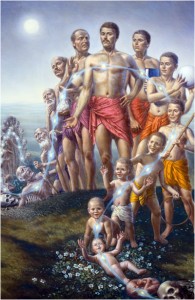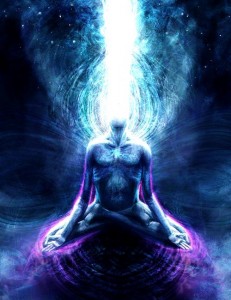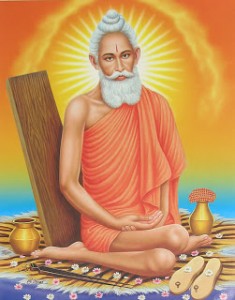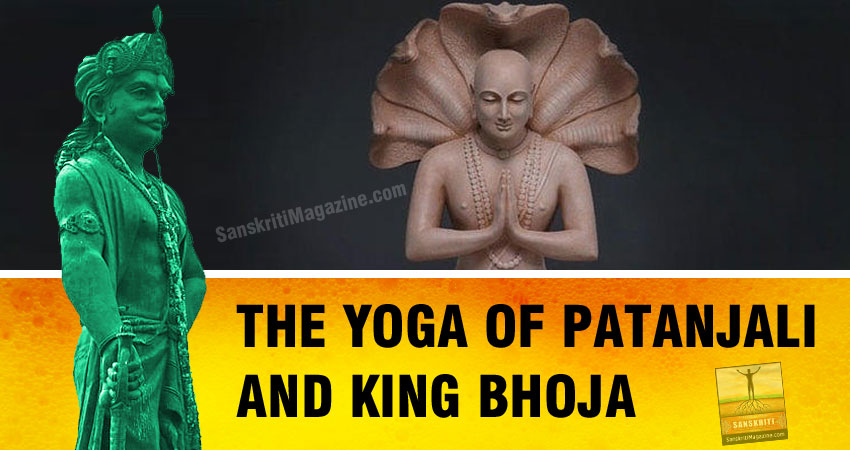According to the Vedas, all living beings, including plants, microbes or developed creatures, are entangled in material bodies from time immemorial. They have been continually migrating from one body to another, the exact form of which depends on their past fruitive actions and the intensity of their desires in their current life. For migrating from one body to another, there are available 8.4 million species on this earth alone.
 Although the original state of these sparks of life is blissful by default, they falsely suffer relentless agony during their seemingly endless journey through this horrible vortex of transmigration. This false sense of suffering, being experienced by the genuinely happy consciousness, is due to a shroud of ignorance that blinds their faculty of discriminating between what is and what appears. In fact, ignorance is a sure symptom of consciousness entangled in matter. It is produced by their failure to differentiate between matter and consciousness.
Although the original state of these sparks of life is blissful by default, they falsely suffer relentless agony during their seemingly endless journey through this horrible vortex of transmigration. This false sense of suffering, being experienced by the genuinely happy consciousness, is due to a shroud of ignorance that blinds their faculty of discriminating between what is and what appears. In fact, ignorance is a sure symptom of consciousness entangled in matter. It is produced by their failure to differentiate between matter and consciousness.
This gloomy situation is not, however, hopeless for a soul arrested in a body. The Vedas announce the voice of hope that this bondage, although from eternity, is not at all permanent and that there exist several regular systems, which can be followed in a controlled manner with a view to breaking out of the vicious cycle of transmigration.
One of these systems is called the yoga as written down by Maharshi Patanjali in the form of sūtras, that is, aphorisms. It has been and is still being practised by yogīs for liberation from their material bondage so that the body is finally cast off. Patanjali systematised a discipline which is as old as the creation of life in our universe. It is hinted in literature that Hiraņyagarbha was the source of the knowledge of yoga. Being the creator of all living entities, he is surely identified as the Recreator of Living Bodies, Brahmā, himself.
Why should yoga be concomitant with the reintroduction of bonded consciousness in bodies? The purpose of creating nature is to provide a continued opportunity to these hapless souls so that they can make renewed efforts to liberate themselves. In this effort the yoga is ever ready as a powerful tool in the hands of man. It is not clear whether the Patanjali of yoga fame and the Patanjali of Mahābhāşya fame are different people or the same personality. From the linguistic point of view, they must be two different personalities. The time of the Patanjali of yoga could not be decided. He lived any time from several centuries to several thousand years BC. In India life is characterised by eternity and the historical bodies it assumes are given no importance.
Now, what is the nature of this so-called liberation for which man has expended the whole of his life or even several lives? Different occasions use different terms for liberation — mokşa (liberation), mukti (deliverance), kaivalya (the unique original status), apavarga (declassification), and so on. Patanjali asserts that, when one achieves kaivalya, one is re-established in one’s original status. When a man achieves this state he becomes aware of the difference between matter and consciousness. He realises that he is different from his body. He casts off his body finally. His sorrows vanish absolutely. He is again in his blissful state. For him there is nothing to be known, nothing remains unknown, and nothing is knowable. He is in a nonmaterial pure conscious form. What he wills obtains. However, he has not gone to somewhere else. Mokşa does not mean some special abode.
It means that his illusions are dispelled, all his doubts are cut asunder, and all his knots of bondage are split off. He is beyond the control of material forces, both functional and emotional. Since he no longer requires Nature, Mother Nature ceases to take care of him and turns her face away from him. In fact, if all the living beings were liberated at the same time, Nature would crumble to nothingness. That does not happen, however, because all are not liberated simultaneously, and Nature continues her existence in cycles.
 Let us now see how the techniques, prescribed by Patanjali, help the yogī dispel his illusion and achieve the state of deathlessness. It is necessary to be familiar with karmachakra (the system of fruitive actions). Signals from the material surroundings fall on the five sense organs and are rearranged as material perceptions on a screen in the brain called the manas (the mind). This perception then passes through a device in the brain called the ahamkāra (the self-tinging device). Now the perception no longer remains a neutral one, but it has now something to do with me. A copy of this selfperception, known as karma (action), is saved in a cell called the karmakośa or the karmāśaya (the action cell). This is the store of my experience. The main branch of the self-tinged perception, however, finally arrives at a device in the brain called the buddhi (intellect).
Let us now see how the techniques, prescribed by Patanjali, help the yogī dispel his illusion and achieve the state of deathlessness. It is necessary to be familiar with karmachakra (the system of fruitive actions). Signals from the material surroundings fall on the five sense organs and are rearranged as material perceptions on a screen in the brain called the manas (the mind). This perception then passes through a device in the brain called the ahamkāra (the self-tinging device). Now the perception no longer remains a neutral one, but it has now something to do with me. A copy of this selfperception, known as karma (action), is saved in a cell called the karmakośa or the karmāśaya (the action cell). This is the store of my experience. The main branch of the self-tinged perception, however, finally arrives at a device in the brain called the buddhi (intellect).
Buddhi is the decision-making device, which now decides what this perception, tinged with myness, actually is and what has to be done with it. The perception may be a still-picture, an audio-video picture, a smell, a sound, a sensation of heat or light, and so on, which have something to do with me. This is the so-called cognitive process. The decision made by the buddhi is generally called the bhoga, something to finish off by undergoing, something to suffer-enjoy. Buddhi, being made of matter, cannot suffer-enjoy the bhoga itself but presents the bhoga to the soul. This can happen due to the reason that the soul and the buddhi are too closely bound to be differentiated. Since the soul is blinded by ignorance, it falsely suffers-enjoys the perception as its own, feeling heat or pain, sorrow or happiness. The bhoga finishes then and there.
If the decision made by the buddhi about the perception is such that some physical action like running, killing, etc. is required, appropriate orders are given to the five work-organs like the hands and feet. That means, one karma induces another karma during the process of undergoing bhoga. Sometimes a decision is such that no action can be taken immediately and the bhoga has to be postponed to a later time. For example, a convict undergoes death penalty the next month, or a ninety-year old unmarried man desires to be killed by his grandson. Such a decision is called a karmaphala ( fruit of action ) or a prārabdha and is saved in a second cell called the prārabdhakośa or the phalāśaya, to be undergone at an appropriate future time, in the current birth or over a span of several births. Prārabdhas cannot be written off through transmigration; it must be finished off only by suffering-enjoying it. It can, however, be transferred from one body to another to be finished off by somebody else.
The sequential process, just described, in which signals through the sense organs are arranged into a perception on the screen of the mind, the perception passes through the self-tinging device, the ahamkāra, a copy of the perception accumulates into the cell of karma as my experience, the perception with myness reaches the buddhi, the buddhi makes a decision about this perception turning it into a bhoga and presenting it to the soul where the bhoga ends, the work-organs are stimulated for mechanical actions, the bhogas with a future date of suffering are accumulated in the cell of prārabdha, — is called the karmachakra, the cycle of actions.
This is like an electronic circuit that runs millions of times in a second. Either this whole system or the final device, the buddhi, is called the chitta in the yoga of Patanjali. The cycle of chitta that functions so rapidly is called the chittavritti, the function of the chitta.
Now, according to the Vedic theory, as long as the karmakośa, the cell of karma, remains full, the living entity continues its journey of transmigration. As soon as this cell becomes empty the soul is liberated. But heaps of karma, that is fruitive actions, have been accumulated in this cell for thousands of past lives and are still being accumulated daily in the current life. Due to the rapid course of the karmachakra, it is extremely difficult for a man to stop any more karma to be accumulated in the cell of karma. The theory, however, says further that it is not impossible to empty the cell fully and come out of the state of repeated birth and death.
Think of the cell of karma as a bottle full of camphor and without a lid. If you do not put any more camphor into the bottle, the camphor in the bottle will evaporate automatically. So, here lies the trick. If we are able to stop the current perceptions, which are formed on the screen of the mind, from being saved in the karmakośa as accumulated karma, the karmakośa will be emptied of its contents automatically.
It is now clear that the only purpose of various methods of spiritual practices followed by those who desire to be liberated is to stop the current karma from being added to the already accumulated mountains of karma. Some of the effective methods are yoga, nişkāma karma (result-independent action), kartritvahīna karma (doing without the sense of authority), bhakti (establishing a worldly relation with God ) and nāma (silent repetition of a string of words, signifying God and invoking His blessings, obtained from an authorised guru).
How does then the system of yoga, initiated by Hiraņyagarbha and systematised by Patanjali, work in stopping the current karma to be accumulated? Yoga prescribes a drastic medicine. Just stop any karma from being generated at all! The practice of a yogī is directed exclusively in this direction. Patanjali’s prescription is very fundamental. Stop the circuit of the karmachakra, the cycle of karma, altogether. Block the chitta-vritti from functioning! How is it possible? What happens to the signals that reach our five sense organs?
 The senses of a yogī reject their respective subjects. He withdraws his ear from sound, skin from touch, eye from form, tongue from taste, and nose from smell. This process of withdrawing the five senses is done through an intense inward concentration of his manas (mind) on a series of subjects that range gradually from coarse to subtle ones. On prolonged concentration on a coarse object, this may last for several years, the chitta of the yogī gets victory over the manifested world. His consciousness achieves a higher level where he acquires the knowledge of distribution of matter. This is the so-called turīya chetanā, the fourth level of consciousness. At this stage the senses of the yogī are completely withdrawn from the coarse aspect of this material world. The yogī cannot be deceived now by any magician.
The senses of a yogī reject their respective subjects. He withdraws his ear from sound, skin from touch, eye from form, tongue from taste, and nose from smell. This process of withdrawing the five senses is done through an intense inward concentration of his manas (mind) on a series of subjects that range gradually from coarse to subtle ones. On prolonged concentration on a coarse object, this may last for several years, the chitta of the yogī gets victory over the manifested world. His consciousness achieves a higher level where he acquires the knowledge of distribution of matter. This is the so-called turīya chetanā, the fourth level of consciousness. At this stage the senses of the yogī are completely withdrawn from the coarse aspect of this material world. The yogī cannot be deceived now by any magician.
This very process of gaining victory over the coarse world is called the Transcendental Meditation by Maharshi Mahesh Yogī, which can be achieved very easily. However, there still remain those subtle material perceptions like the ultrasound and the infrared which continue to impel the karma cycle and generate karma. The yogī then concentrates on a subtle object, gets victory over the subtle world, and reaches the next higher level of consciousness where, besides the knowledge of distribution of matter, he realises the property of matter, too. This is called turīyātīta chetanā, the fifth level of consciousness. Since he now knows why an object floats or sinks in water, he can easily cross a river by walking on its surface. Making himself small in size, he can pass through a key-hole.
It will now be relevant to talk about the levels of consciousness. A man can live in seven gradually higher levels of consciousness: jāgrat chetanā (the state of wakefulness), nidrā chetanā (the state of deep sleep), suşupti chetanā (the state of dreamfulness), turīya chetanā (the fourth state of knowledge of distribution of matter), turīyātīta chetanā (the fifth state of control over the properties of matter), īśvara chetanā (the state of discriminating between I and my body), and brāhmī chetanā (the state of liberation that He is a gold mountain and we are gold dust).
These junctions of levels of consciousness are established along the vertebral column from its lowermost tip up to the top of the brain. It is a matter of sadness that throughout his life a man lives only in the three lower levels of consciousness, — jāgrat, nidrā and suşupti, — being oblivious of the other four states he can and should achieve.
As the yogī achieves gradual victories over the course to the subtle subjects, his current karmas are generated at a lesser and lesser speed and his accumulated karmas evaporate at greater and greater speed. He feels gradual relief from an age-old burden, and a feeling of happiness emerges, which was never felt before. At the sixth level of his consciousness, the īśvara chetanā, the yogī finally realises that he and his body are two fundamentally different subjects and that he has now acquired the ability to leave his body temporarily and make distant journeys. Suddenly the memory of a few of his past lives preceding his current life dawns on him with a baffling effect.
This is the stage when the yogī is authorised to become a guru. He is not yet liberated, till he achieves the seventh brāhmī level of consciousness. This is the state when the yogī finally casts his body and becomes liberated. Technically speaking, the yogī does not need to remain in his body any longer. There are, however, two situations when a liberated soul remains in the body. First, due to the loss of all of his accumulated karmas, the yogī achieves mokşa, but his prārabdha cell might not be empty. This cell might still contain some karmaphala, fruits of actions, to be suffered-enjoyed at an appropriate future time. This prevents him from casting his current final body. He just lingers on in a stupid, intoxicated and loathsome state.
This is called the jīvanmukta state, liberated but overstaying in a body. Theoretically, once liberated, a yogī never again gets entangled in the net of karma. If no longer accumulated, where do then the physical and mental actions of a jīvanmukta yogī settle? The answer can be found from a hint provided by Lord Kŗşņa in the Bhagavadgītā, where He says that karma is generated by the Brahma, the aspect of God knowable by man through speculation. Hence we can deduce that all the physical and mental karmas done by a jīvanmukta yogī must bounce back to the Brahma. Indeed it is clearly mentioned so in the Paramārthasāra written by Ādiśeşa, where it is claimed that even grave sins like killing Brāhmins are not registered in his karmakośa.
King Prahlāda was reported by his ministers, as the Śrīmadbhāgavatam says, that a very rare jīvanmukta saint lived in a vegetative state not very far from his capital. Accompanied by some scholars and ministers, Prahlāda met this saint and had an interesting discourse with him. The second type of a liberated soul in a material body is one who takes birth willingly with a view to completing a particular mission (janmasiddha). Śrī Rāmakrishna, the spiritual master of Swāmī Vivekānanda, can be referred to as an example of a liberated soul taking birth willingly for the special mission of re-establishing faith in the Vedic wisdom.
It is not irrelevant to raise the question:
What is the composition of karma? Is it matter or consciousness?
Karma is certainly not consciousness, because is it produced by material signals, which are either matters themselves, like light, or configuration of matter, like sound. Besides, karma creates bhoga and prārabdha, both of which are sorrows or sugar-coated sorrows. God is kind absolutely, and so does not create sorrow for the bonded soul. Karma is not matter either.
Suppose that you have written, “Speak the Truth,” on a sandy beach with a stick. Nothing has been added to the sand. Some sand particles have changed their positions only. An instruction is, nevertheless, created without material gain or loss but with material change of position. A similar thing happens when a song is recorded in a tape. Only the magnetised particles in the tape shift their positions. You can wipe off the writing on the sand or the song from the tape without subtracting any matter from them. If all the records of a particular song are deleted, the voice of the singer still remains beyond the material world from where all sound instructions are created and spread. Clearly, such instructions are programmes, as are known by the computer people. Like any programmes, karmas can be recorded as well as deleted.
Lastly, we are compelled to raise an unnecessary question: Is the system of yoga effective for liberation of man? This question has been heard during the last two centuries. Let us give an example of a yogī who lived in the British period. In the middle of the 18th century some 60-year old guru Bhagavān Ganguly lived in a village about 50 Km northeast of Calcutta in the present day province of West Bengal in India. He was a great scholar, an expert yogī, and a venerable guru.
Due to various domestic obstacles, he could not achieve much in his yogic practice. Although he was a Brāhmin of firm conviction, he began to doubt seriously about the efficacy of the yogic system in liberating the mankind. He was eagerly waiting for his rebirth so that he could restart his practice from the very childhood for verifying the truth about the yoga. In the mean time, two 11-year old Brāhmin boys of the same village, Lokanātha and Veņimādhava, were handed over to him by their parents with the request that the guru take them to some secluded place, far away from their village, and convert them to sannyāsīs (mendicant yogīs).
 In India it has always been the traditional belief that if a boy from a family renounces the world and becomes a sannyāsī, several generations of his family will be liberated automatically from repeated birth and death. The old guru did not want to lose this opportunity, accepted the boys as his disciples, took them to places west of Bengal, kept them in secluded places, far away from the human society, fed them with the alms he would bring daily by begging in villages door to door, and rigorously trained them in the practice of yoga.
In India it has always been the traditional belief that if a boy from a family renounces the world and becomes a sannyāsī, several generations of his family will be liberated automatically from repeated birth and death. The old guru did not want to lose this opportunity, accepted the boys as his disciples, took them to places west of Bengal, kept them in secluded places, far away from the human society, fed them with the alms he would bring daily by begging in villages door to door, and rigorously trained them in the practice of yoga.
One day, at the age of 55, Lokanātha started weeping. Guru Bhagavān asked him the reason. Lokanātha replied, “I know who I am. I know who I was in several of my past lives. You have taken so much trouble for us at this advanced age. I feel great pain to see that you still remain in ignorance.” Guru Bhagavān consoled him, “Don’t grieve for me! I am happy to know that Patanjali is right. In my next life I will be your disciple. You will then get enough time to lift me up.” Some time in the middle of the 19th century, a stupid man-like creature suddenly appeared, as if from nowhere, to the village of Baradi near Dhaka. This was Lokanātha, known later as Bābā Lokanātha Brahmachārī. Earlier, he had travelled as far as the Atlantic coast and the North Pole. This mahāyogī, who was born in 1730, cast his mortal body in 1890 at Baradi on a date and at a time announced by him earlier. At present millions of people in West Bengal and Bangladesh worship him as the Brahmachārī of Baradi.
King Bhoja and his commentary on Yoga:
Hundreds of commentaries and notes on commentaries have been written on the yogadarśana of Patanjali during the past two millennia. Of these about 30 commentaries have stood the test of time. The following are some of the well-known commentaries on Patanjali:
- Vyāsabhāşya by Maharshi Vedavyāsa.
- Tattvavaiśāradī by Vācaspati Miśra.
- Yogavārtika by Vijňānabhikşu.
- RājamārtaņDa by King Bhojadeva.
- Yogasūtravritti by NāgeśabhaTTa.
- Yogasūtrārthachandrikā, etc. by Ananta.
- YogavŗttisaMgraha by Umāpati Miśra.
- Yogamaņiprabhā by Rāmānanda Sarasvatī.
- Yogasūtrabhāşya by Rāmānuja.
- Yogapradīpikā by Baladeva Miśra.
The Bhojavritti, the short commentary on the yogasūtras by King Bhojadeva, or simply King Bhoja, is known as the Rājamārtaņdavritti. Bhoja belonged to the Paramāra Dynasty within the Rajput clan, which inhabits in and around the present day province of Rajasthan in the western part of India. He ruled over Malwa during the first half of the 11th century AD. His forefathers were kings in the hilly region of Rajasthan called Abu and later shifted to the east and settled in the fertile region of Malwa. Earlier, the famous city of Ujjayinī (Ujjain) was their capital. Later King Bhoja shifted his capital to the city of Dhārā. For this reason he is usually referred to as the Dhāreśvara and the Dhārādhipati (The Lord of Dhārā). Bhoja’s father was King Sindhurāja or King Sindhula, who died in 1010 AD. Bhoja ruled Malwa during 1018 – 1062. There is some controversy about the year of his death.
King Bhoja is famous for his scholarship, valor and popularity. He revived the tradition of Sanskrit culture and patronised Brāhmins to compose original treatise. He established a huge Sanskrit university in Dhārā, where students from distant places would reside for intensive research on all the branches of literature, astrology, science, and technology. Bhoja himself wrote about 84 original books on arts, literature, grammar, treatment and medicine, yoga, astrology, architecture, religion and philosophy, law and jurisprudence, and so on. It is rare for a king to have so much knowledge to write so many original books on so diverse a subject, especially when it is known that he was busy most of the time in fighting the neighbouring kings, ever expanding his vast kingdom, and even once challenging Sultan Mahmud of Ghazni, who destroyed the temple of Somnath several times.
The Bhojavritti is light and crisp. It is very useful for students. It is a good introduction to the long Indian tradition of reading notes and commentaries on a piece of darśana. Usually a commentator introduces doubts and differences of opinion of other commentators and accepts or demolishes them through his own rigid logic. However, Bhoja has announced in the very preface of his vritti that he is presenting his own explanation of the aphorisms in a straightforward manner, that he has avoided all sorts of alternative explanations, and that he has meticulously avoided all sorts of polemics. However, he has not spared hard words for other commentators, saying that all of them have avoided explaining phrases which are rather difficult to understand, and that they are in the habit of explaining in great details what are fairly easy to comprehend.
Realising the importance of the Bhojavritti, that is, the Rājamārtaņdavritti, several scholars wrote their own explanatory notes on it. Translations of the Bhojavritti in English and Hindi are easily available. An English translation by Rajendralal Mitra appeared in the Bibliotheca Indica in 1883.
~ Dr. Suryansu Ray











